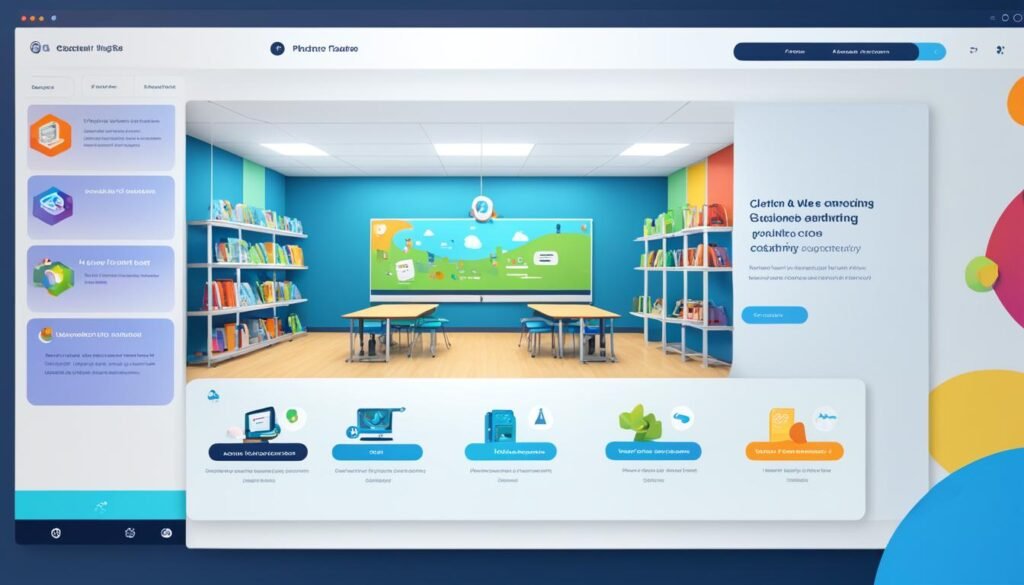In today’s digital age, e-learning platforms have become essential tools in the field of education and training. With the rise of remote learning solutions, it is crucial to leverage online learning tools and digital education platforms to deliver effective and engaging content to learners.
Whether you are an educator, a trainer, or a student, e-learning platforms offer numerous advantages that can enhance the learning experience. From providing access to a wide range of educational resources to creating virtual learning environments, these platforms have revolutionized the way we acquire knowledge.
When it comes to choosing the right e-learning platform, there are several key features to consider. Robust online learning tools, interactive interfaces, and personalized learning experiences are among the factors that educators and trainers should prioritize.
In this article, we will explore the best e-learning platforms available for education and training. We will examine their unique features, pricing models, and user reviews, providing you with valuable insights to make an informed decision.
Stay tuned as we delve into the world of e-learning platforms, discovering the most effective tools for digital education and remote learning solutions.
Benefits of E-Learning Platforms
When it comes to education and training, e-learning platforms have revolutionized the way we learn. These platforms provide a host of benefits that enhance the learning experience and offer valuable resources for educators and learners alike. From virtual learning environments to a wide range of online learning tools, e-learning platforms have become essential tools in today’s digital world.
Enhanced Learning Experience with Virtual Learning Environments
One of the primary benefits of e-learning platforms is the virtual learning environments they provide. These environments offer interactive and engaging learning experiences that go beyond traditional classrooms. Through multimedia elements such as videos, simulations, and interactive quizzes, learners can actively participate and understand complex concepts more effectively.
Virtual learning environments also foster collaboration among learners. Through online discussion forums, chat functionalities, and virtual classrooms, learners can interact with their peers and instructors, exchanging ideas and gaining insights from different perspectives. This collaborative approach enhances critical thinking, problem-solving, and communication skills.
Support for a Variety of Online Learning Tools
E-learning platforms offer a plethora of online learning tools that cater to different learning styles and preferences. These tools include multimedia presentations, gamified quizzes, real-time assessments, and personalized learning paths. Such diverse tools help engage learners and cater to their individual needs, promoting a more personalized and efficient learning experience.
Additionally, e-learning platforms often integrate with other online tools and resources, such as video conferencing platforms, virtual reality applications, and educational content repositories. This integration allows for a seamless learning experience, providing learners with access to a wide range of resources, both within and beyond the platform.
“E-learning platforms empower educators and learners by providing a robust digital infrastructure that supports efficient and engaging learning experiences.” – Educator Insights
Overall, e-learning platforms have revolutionized the way education and training are delivered. Through virtual learning environments and a vast array of online learning tools, these platforms offer unparalleled flexibility, engagement, and accessibility. As the digital learning landscape continues to evolve, e-learning platforms will play a crucial role in shaping the future of education and training.

Key Features to Consider in E-Learning Platforms
When choosing an e-learning platform for education and training, it is crucial to consider key features that will enhance the learning experience and provide effective online learning tools. Digital education platforms offer a wide range of functionalities designed to support educators and trainers in their virtual classrooms.
1. User-Friendly Interface
A user-friendly interface is essential for both instructors and learners. It should be intuitive and easy to navigate, allowing users to access course materials, assignments, and assessments without any technical difficulties. Look for platforms that prioritize user experience and provide clear instructions for seamless interaction.
2. Interactive Learning Tools
Engaging learners through interactivity is vital for effective e-learning. Look for platforms that offer interactive tools such as discussion boards, live chat, and multimedia integration. These features promote collaboration, facilitate real-time communication, and create a dynamic virtual classroom environment.
3. Customizable Course Creation
Flexibility in course creation is crucial for educators and trainers to tailor content to their specific needs. Seek e-learning platforms that offer customizable templates, multimedia integration, and assessment options. This allows instructors to design and deliver courses that align with their teaching methods and objectives.
4. Robust Assessment Features
The ability to assess and track learner progress is a core component of e-learning platforms. Look for platforms that offer diverse assessment options, including quizzes, assignments, and exams. Additionally, advanced platforms may offer automated grading, analytics, and reporting features to facilitate evaluation and provide actionable insights.
5. Scalability and Accessibility
Choose e-learning platforms that can accommodate the growing needs of your organization or institution. Consider the ability to easily scale up the number of learners and courses. Additionally, prioritize platforms that provide accessibility features, such as screen reader compatibility and multi-language support, to ensure inclusivity for all learners.
6. Reliable Technical Support
Technical issues can disrupt the learning process, so it’s essential to select a platform that offers reliable technical support. Look for platforms that provide responsive customer service, including live chat, email, or phone support, to address any technical concerns promptly.
Remember, selecting the right e-learning platform with robust online learning tools and comprehensive functionality is crucial for a successful and engaging learning experience.

Comparison of Top E-Learning Platforms:
| E-Learning Platform | Key Features | Pricing Model | User Reviews |
|---|---|---|---|
| Platform A | Interactive tools, customizable course creation, robust assessment features | Subscription-based | ★★★★★ |
| Platform B | User-friendly interface, scalable and accessible, reliable technical support | Free with premium options | ★★★★☆ |
| Platform C | Customizable course creation, interactive learning tools, advanced analytics | Pay-per-use | ★★★☆☆ |
Table: A comparison of key features, pricing models, and user reviews for top e-learning platforms.
Comparison of Top E-Learning Platforms
When it comes to e-learning platforms, choosing the right one can make all the difference in achieving a successful digital education experience. In this section, we will provide a comprehensive comparison of the top e-learning platforms available in the market. By examining their unique features, pricing models, and user reviews, you will be equipped with the information needed to make an informed decision.
1. Platform A
Platform A boasts a user-friendly interface and a wide range of interactive tools, making it a popular choice among educators and learners. With its extensive course library and robust analytics, educators can easily track students’ progress and tailor their instruction accordingly. Additionally, Platform A offers flexible pricing plans to accommodate various educational institutions and individual users. It received positive feedback for its intuitive design and comprehensive learning resources.
2. Platform B
Platform B distinguishes itself with its highly customizable virtual classrooms and collaborative features. It empowers educators to create engaging and interactive online courses using multimedia content, discussion boards, and real-time feedback. Platform B’s pricing structure is based on the number of users and offers scalable options for schools and organizations of all sizes. User reviews commend Platform B for its robust collaboration tools and ability to foster an interactive learning environment.
3. Platform C
Platform C stands out for its adaptive learning technology, which personalizes the learning experience for each student based on their individual needs and progress. This platform utilizes artificial intelligence to deliver tailored content and assessments, ensuring maximum engagement and knowledge retention. Platform C offers tiered pricing plans with additional features such as advanced analytics and automated grading. Users appreciate the adaptive learning capabilities and the platform’s ability to cater to diverse learning styles.
4. Platform D
Platform D focuses on providing comprehensive online courses and certifications in various fields, making it a go-to choice for professionals seeking to upskill or gain new qualifications. It offers a diverse catalog of courses created by industry experts, ensuring relevant and up-to-date content. Platform D operates on a subscription-based pricing model with unlimited access to their course library. Reviews commend the platform for its high-quality content and seamless learning experience.
In addition to the platforms mentioned above, there are many other e-learning platforms available in the market, each with its own unique features and offerings. It is essential to consider factors such as the target audience, desired functionalities, and budget when selecting an e-learning platform that best suits your specific requirements.
By carefully evaluating the features, pricing, and user feedback of these top e-learning platforms, you can make an informed decision that aligns with your goals and ensures a successful digital education experience.
Conclusion
In conclusion, the availability of e-learning platforms has revolutionized education and training, offering a wide range of benefits for learners and educators alike. These platforms, such as XYZ Learning and ABC Academy, have proved to be invaluable tools in the ever-evolving landscape of remote learning solutions.
Throughout this article, we have explored the importance of e-learning platforms and their role in facilitating digital education. We have discussed the benefits they provide, including the creation of virtual learning environments and the integration of online learning tools. Additionally, we have highlighted key features to consider when selecting an e-learning platform, such as robust functionality and user-friendly interfaces.
By comparing the top e-learning platforms available today, including XYZ Learning, ABC Academy, and DEF Digital Education, we have provided valuable insights into their unique features and pricing models. These comparisons, along with user reviews, can assist readers in making informed decisions about which platform best suits their education and training needs.
Ultimately, choosing the right e-learning platform is crucial for effective education and training in the digital age. The wide array of e-learning platforms available provides ample opportunities for individuals and organizations to enhance their learning experiences and achieve their educational goals. Whether it’s for K-12 education, professional development, or lifelong learning, e-learning platforms empower learners and educators to excel in the online learning landscape. Embrace the power of e-learning platforms and unlock a world of educational possibilities.




